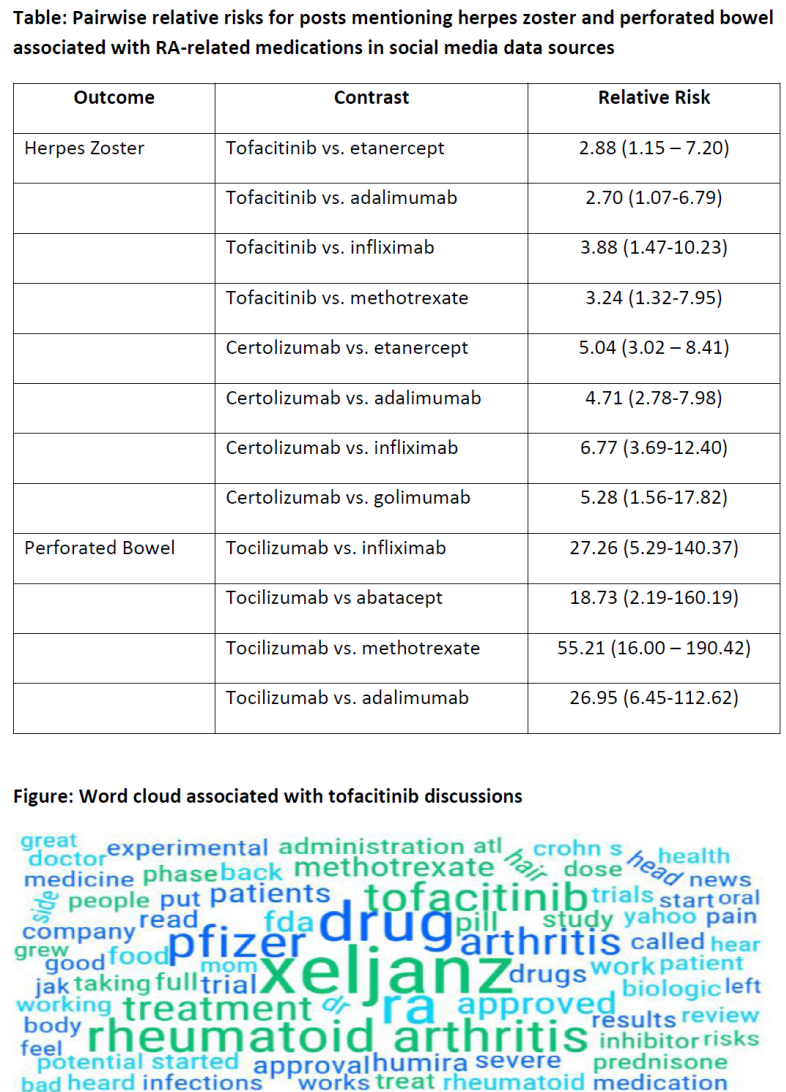Session Information
Date: Sunday, November 8, 2015
Session Type: ACR Poster Session A
Session Time: 9:00AM-11:00AM
Background/Purpose:
The data sources available to answer comparative effectiveness and safety questions shortly after medication licensure may be limited. Social media may provide a unique resource to complement traditional data sources.
Methods:
We used the TREATO platform to crawl all publically-available social media data including Facebook, blogs, and discussion boards for posts mentioning inflammatory arthritis (e.g. rheumatoid, psoriatic arthritis). Safety events were self-reported by patients and mapped to medical ontologies, resolving synonyms. Disease and symptom-related treatment indications (e.g. arthritis, joint pain) were manually redacted and excluded. The unit of analysis was unique terms in posts. The focus of the analysis was more recently licensed US drugs (tofacitinib,tocilizumab).
Pre-specified conditions were selected based upon safety signals from clinical trials and reported as pairwise odds ratios (ORs); RA drugs were compared with Fisher’s exact test. Empirically-identified events were analyzed using disproportionality analysis [similar to methods used to analyze FDA AERS data], and reported as relative reporting ratios (RRRs) and proportional reporting ratios (PRRs).
Results:
As of 6/2015, there were 549,939 arthritis-related posts discussing tofacitinib (n=543), etanercept (n=17,173), adalimumab (n=12,418), abatacept (n=2,776), and tocilizumab (n=821). Posts were predominantly U.S. (75%) and had patient authors (86%). The most common sources were Facebook, Arthritis Foundation, RemedySpot, Dailystrength, ArthritisCare and RA Warrior. The age distribution was <19(17%), 19-29(22%), 30-39(20%), 40-49(17%), 50-54(18%), and 65+ (6%). Common tofacitinib themes are shown as a word cloud (Figure).
For herpes zoster posts (n=888), ORs were significantly increased for tofacitinib compared to other RA therapies (Table); ORs for certolizumab-associated shingles mentions were higher as well (not shown). ORs for mentions of perforated bowel (n=11) were higher for tocilizumab vs. other therapies.
RRRs and PRRs associated with tofacitinib were highest for conditions related to baldness and hair regrowth, infections and cancer. Ongoing work is evaluating the clinical validity of the cases based upon available narratives and refining the analysis to restrict to confirmed cases.
Conclusion:
Social media is a challenging yet promising data source that may be used to complement traditional approaches for comparative effectiveness research for new medications shortly after licensure.
To cite this abstract in AMA style:
Curtis JR, Willig J, Safford M, Coe J, O'Hara K, Sa'adon R. Use of Social Media Data for Comparative Effectiveness and Safety Research: An Example from Rheumatoid Arthritis [abstract]. Arthritis Rheumatol. 2015; 67 (suppl 10). https://acrabstracts.org/abstract/use-of-social-media-data-for-comparative-effectiveness-and-safety-research-an-example-from-rheumatoid-arthritis/. Accessed .« Back to 2015 ACR/ARHP Annual Meeting
ACR Meeting Abstracts - https://acrabstracts.org/abstract/use-of-social-media-data-for-comparative-effectiveness-and-safety-research-an-example-from-rheumatoid-arthritis/

